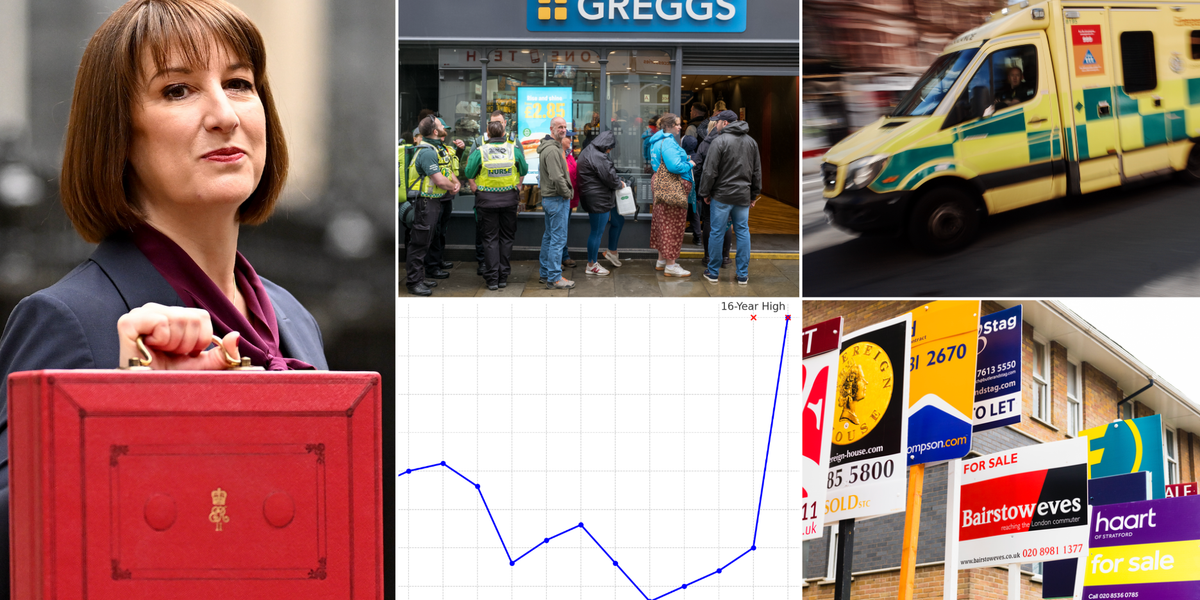If a week is a long time in politics, this one has been a decade for the Chancellor.
Rachel Reeves faces two grim choices: slash public spending or raise taxes further. She has ruled out the latter for now, but as borrowing costs soar, this position will become increasingly untenable.
On Wednesday, the 10-year gilt yield reached its highest level in 16 years amid a dramatic sell-off of government debt in the global market, and investors took fright at the UK’s borrowing needs and potential for stagflation — a combination of sluggish growth and persistent inflation.
To make matters worse, the pound has weakened against the dollar, reaching its lowest level since late 2023.
This has raised the alarm in financial circles, with Martin Weale, a former member of the Bank of England’s rate-setting monetary policy committee, telling Bloomberg News: “We haven’t really seen the toxic combination of a sharp fall in sterling and long-term interest rates going up since 1976. That led to the IMF bailout.”
He added: “So far, we are not in that position, but it must be one of the Chancellor’s nightmares.”
Reeves had already announced tax rises amounting to £40billion in her Autumn budget, including increases in employer National Insurance contributions, capital gains tax, inheritance tax, and changes to tax regimes for non-domiciled residents and private schools.
So the stage is set for a painful couple of years but how bad will things get for British taxpayers? Here are five measurable ways
Increased national insurance contributions for employers
The budget increased employer National Insurance contributions (NICs) by 1.2 percentage points, aiming to raise an additional £25billion annually. This increase in the cost of employment could lead to lower wage growth as businesses might pass these costs onto employees or absorb them by reducing future salary increases or hiring fewer workers.
The Office for Budget Responsibility (OBR) has indicated that this could result in a workforce reduction equivalent to 50,000 jobs.
This scenario would directly impact individual earnings and employment opportunities, especially for lower-paid roles, potentially leading to higher unemployment or underemployment.
Boss of high street giant Next has signalled as much.
“The biggest risk is employment. I’m more concerned about the availability of jobs, particularly at or around the National Living Wage level. That’s where the burden of tax has fallen the hardest,” he told the Telegraph, adding: “Given the scale of the cost increases, I think it will ultimately affect the number of jobs at those levels.”
Higher borrowing costs and mortgage rates
With the Government’s decision to increase borrowing significantly, there’s an expectation that interest rates might remain higher for longer.
This increase in borrowing costs has led to a rise in government bond yields, which in turn influences mortgage rates. For homeowners, this means potentially higher monthly mortgage payments, particularly affecting those with variable or soon-to-be-renewed fixed-rate mortgages.
The OBR has warned that this could add around £360 per year to the average mortgage if rates are fully passed on to borrowers, impacting household budgets significantly.
It’s already affecting Sonia swap rates, which reflect lenders’ expectations of future interest rates and are crucial in determining the pricing of fixed-rate mortgages.
Five-year swap rates have risen from 3.8 per cent to 4.12 per cent, while two-year swaps have increased to 4.26 per cent from four per cent since early December.
Yesterday alone saw five-year swaps jump by 0.14 percentage points in a single day.
Stuart Cheetham, chief executive of MPowered Mortgages, warned that market uncertainty is driving volatility in swap rates, affecting mortgage rates.
He said: “Although some lenders, including us, have reduced mortgage rates, these reductions are likely to be short-lived.”
Price rises
The higher NICs for employers, coupled with other fiscal measures like increases in minimum wage, are likely to increase the operational costs for businesses.
As these costs rise, businesses might be forced to increase the price of goods and services to maintain profit margins. This could lead to inflationary pressures, reducing real income for consumers as their purchasing power diminishes.
This effect is compounded by the broader warning from business groups that these measures could lead to a slowdown in economic growth, further exacerbating cost pressures.
A survey conducted by the Bank of England in December revealed that over half of British businesses anticipate reduced profits, increased prices, and workforce reductions due to the recent tax hikes.
Specifically, 54 per cent of finance directors plan to raise prices to counterbalance higher taxes, 64 per cent foresee narrower profit margins, and 53 per cent expect to lay off staff.
This is already kicking in. Greggs, a prominent UK bakery chain, has announced price increases for several menu items, including sausage rolls, coffee, and steak bakes, attributing this to rising business costs primarily due to higher National Insurance contributions and wage increases.
Slashing public services
Reeves is reportedly considering deeper cuts to public services amid rising borrowing costs.
Economists warn that reduced public spending could dampen economic growth, especially if cuts affect investment in infrastructure, education, or healthcare.
Reducing healthcare spending specifically could have dire implications, especially with the NHS already under strain.
This might mean fewer resources for patient care, maintenance of facilities, or investment in new technology.
The waiting list already stands at 7.5 million, with more than three million having already waited longer than the 18-week target.
Trimming public spending could exacerbate this crisis and stymie Starmer’s efforts to clear the backlog by giving patients more choice over where they are treated.
Indeed, an Institute for Government report recently noted that “Day-to-day public service spending is set to grow quite slowly beyond next year, which the government may find frustrates progress on its missions”.
Former Brexit secretary Lord Frost has sounded the alarm over cuts to public services, tweeting: “We cannot continue to expand public services at the pace we have been without significant economic growth to back it up. Cuts are inevitable, but they must be strategic, not just across-the-board reductions.”
LATEST MEMBERSHIP DEVELOPMENTS
Investor free-zone
All of the above will create an environment that’s unattractive to investors.
Reduced investment could lead to less innovation, slower productivity growth, and a reluctance to expand operations or hire new staff, thus setting in motion a doom loop.
Economists say the danger signs are everywhere, with Doctr Andrew Sentance, an independent business economist warning that “Lack of confidence in financial markets is a big issue for Rachel Reeves. But she shows no interest in the issue and ploughs on regardless”.
This week’s jump in gilt yields indicates a lack of investor confidence.


